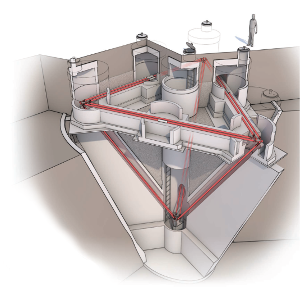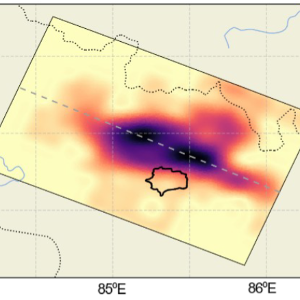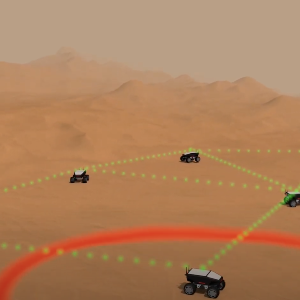Prof. Heiner Igel
Professor für Geophysik und Seismologie
Postanschrift:
Theresienstr. 41
80333 München

I began studying geophysics at the Technische Hochschule Karlsruhe (now KIT) in 1982. Before getting my Diploma degree I spent two years in Edinburgh working as a research student with Prof. Stuart Crampin. From 1990-1993 was supervised by Profs Albert Tarantola and Peter Mora at the Institut de Physique du Globe in my PhD project on seismic modelling and inversion. We were lucky to have access to one of the first parallel machines, the Connection Machine CM-2. From 1994-1999 I was a postdoctoral researcher at the Institute of Theoretical Geophysics at the University of Cambridge, UK, working primarily on global wave propagation. Since 1999 I am a professor of seismology at LMU.
I am interested in all aspects of seismic waves from observing then on Earth, in the oceans, and on planets; how to use ground motions to infer the structure of the interior or the dynamics of seismic sources; how to accurately simulate seismic wave propagation to match observations. Currently my main research interest is how to understand complete ground motion including rotational motions, how to observe them accurately, and how to use the combined observations (6 DoF) with seismometers to solve science problems.

Graphical illustration of the ROMY ring laser installed in Fürstenfeldbruck (from Hand) | © Science, 2017
We are interested in integrating all aspects of rotational ground motion into Earth System Monitoring. This applies to the observation of earthquakes, the natural and induced seismic background noise, the potential of using these observations in planetary seismology, volcanology, oceanography, and borehole geophysics. While using ring lasers at our Observatory Fürstenfeldbruck and at the Fundamentalstation Wettzell we also push the development of portable rotation sensing systems and make use of our pool of rotations sensors such as BlueSeis-3A and lower-resolution 6-component inertial measurement units (IMU). We also see applications in structural health monitoring.
Tang, L., Igel, H., Montagner, J.-P., & Vernon, F. (2024). Seismic anisotropy from 6C ground motions of ambient seismic noise. Journal of Geophysical Research: Solid Earth, 129, e2024JB028959. https://doi.org/10.1029/2024JB028959
Tang, L., Igel, H., & Montagner, J.-P. (2023). Anisotropy and deformation processes in Southern California from rotational observations. Geophysical Research Letters, 50, e2023GL105970. https://doi.org/10.1029/2023GL105970
Igel, H., K.U. Schreiber, A. Gebauer, F. Bernauer, S. Egdorf, A. Simonelli, C.-J. Lin, J. Wassermann, S. Donner, C. Hadziioannou, S. Yuan, A. Brotzer, J. Kodet, T. Tanimoto, U. Hugentobler, and J.-P.R. Wells. Romy: A multicomponent ring laser for geodesy and geophysics. Geophysical Journal International, Volume 225, Issue 1, April 2021, Pages 684–698, https://doi.org/10.1093/gji/ggaa614
Bernauer, F., Behnen, K., Wassermann, J., Egdorf, S., Igel, H., Donner, S., Stammler, K., Hoffmann, M., Edme, P., Sollberger, D., Schmelzbach, C., Robertsson, J., Paitz, P., Igel, J., Smolinski, K., Fichtner, A., Rossi, Y., Izgi, G., Vollmer, D., ... Brokesova, J. (2021). Rotation, Strain, and Translation Sensors Performance Tests with Active Seismic Sources. Sensors, 21(1), 264. https://doi.org/10.3390/s21010264

Illustration of peak ground motion from a simulation of the 2015 M7.8 Gorkha Earthquake in the Kathmandu Basin | © Zihua Niu
We continue to push seismic simulation technology to become ever more realistic. This involves extending rheologies to nonlinear behavior and exploring the effects on ground motion and the dynamics of earthquake rupture. Furthermore we aim at making (expensive) supercomputer wavefield simulations accessible and usable by the science community.
Niu, Z., Gabriel, A.-A., Seelinger, L., & Igel, H. (2024). Modeling and quantifying parameter uncertainty of co-seismic non-classical nonlinearity in rocks. Journal of Geophysical Research: Solid Earth, 129, e2023JB027149. https://doi.org/10.1029/2023JB027149
Niu, Z., Gabriel, A.-A., Wolf, S., Ulrich, T., Lyakhovsky, V., & Igel, H. (2025). A discontinuous Galerkin method for simulating 3D seismic wave propagation in nonlinear rock models: Verification and application to the Mw 7.8 2015 Gorkha, Nepal Earthquake. Journal of Geophysical Research: Solid Earth, 130, e2025JB031378. https://doi.org/10.1029/2025JB031378

Seismic Exploration for Future Space Missions (illustration from https://www.youtube.com/watch?v=LvpKsUklCDs) | © DRL KN Swarm Systems
How does the ground move on planetary objects like the moon, Mars, asteroids, comets? What are good instrumentation strategies to characterize these motions? What sensor do we need? How can we design experiment in these challenging environments. These questions we address in some of our projects.
Bernauer, F. R.F. Garcia, N. Murdoch, V. Dehant, D. Sollberger, C. Schmelzbach, S. St¨ahler, J. Wassermann, H. Igel, A. Cadu, D. Mimoun, B. Ritter, V. Filice, ¨ O. Karatekin, L. Ferraioli, J.O.A. Robertsson, D. Giardini, G. Lecamp, F. Guattari, J.-J. Bonnefois, and S. de Raucourt. Exploring planets and asteroids with 6dof sensors: Utopia and realism. Earth Planets Space 72, 191 (2020). https://doi.org/10.1186/s40623-020-01333-9
Keil, S., Igel, H., Schimmel, M., Lindner, F., & Bernauer, F. (2024). Investigating subsurface properties of the shallow lunar crust using seismic interferometry on synthetic and recorded data. Earth and Space Science, 11, e2024EA003742. https://doi.org/10.1029/2024EA003742
Joshi, R., Knapmeyer-Endrun, B., Mosegaard, K., Igel, H., & Christensen, U. R. (2021). Joint inversion of receiver functions and apparent incidence angles for sparse seismic data. Earth and Space Science, 8, e2021EA001733. https://doi.org/10.1029/2021EA001733